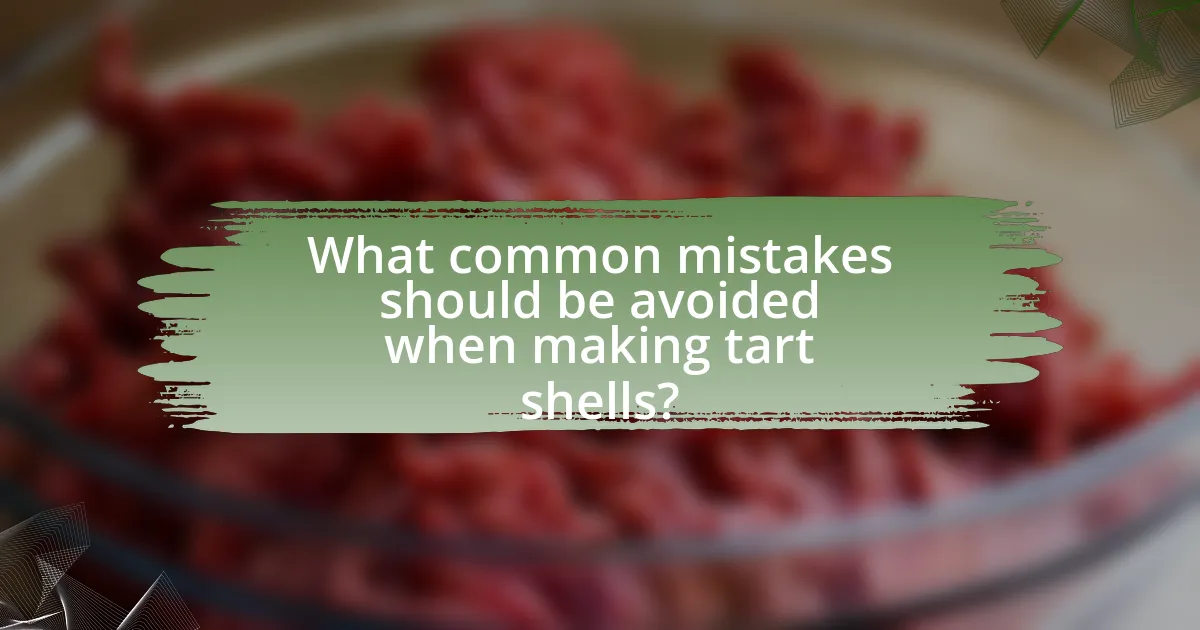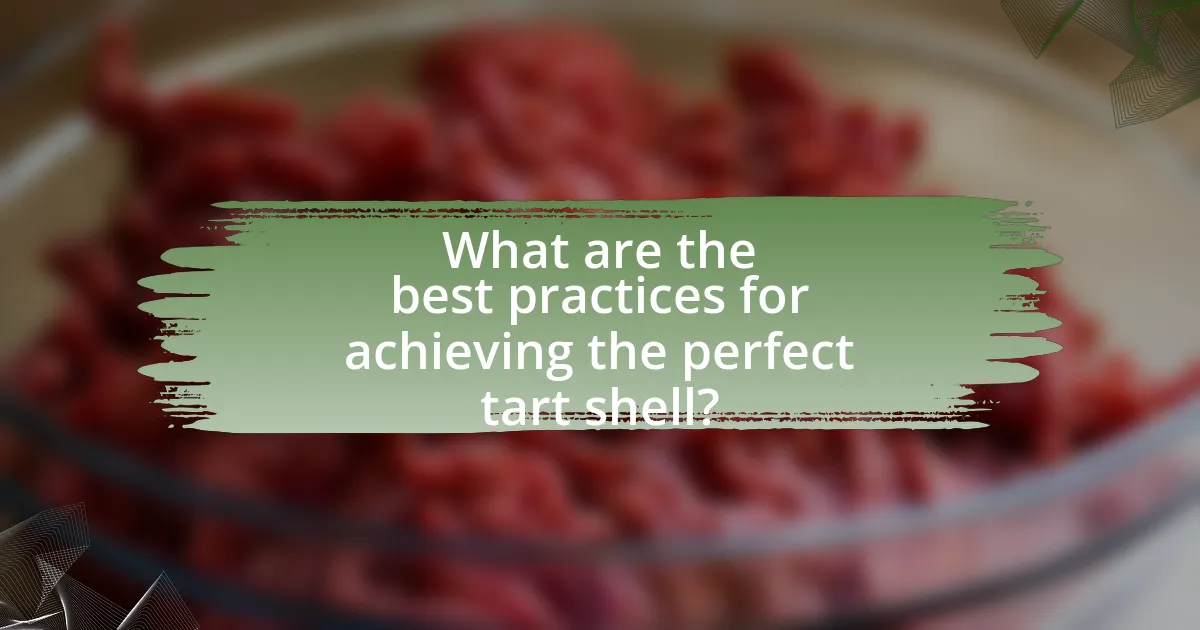The article focuses on essential techniques for achieving the perfect tart shell, emphasizing the importance of ingredient measurement, chilling the dough, and blind baking. It discusses how the choice of ingredients, particularly flour and fat ratios, directly impacts the texture and flavor of the tart shell. Various preparation methods, including traditional pastry and press-in techniques, are explored, along with the significance of chilling the dough to prevent shrinkage and ensure flakiness. Additionally, the article addresses common mistakes to avoid, effective blind baking practices, and troubleshooting tips for achieving optimal results in tart shell preparation.

What are the essential techniques for achieving the perfect tart shell?
To achieve the perfect tart shell, it is essential to use techniques such as proper ingredient measurement, chilling the dough, and blind baking. Accurate measurement of flour, butter, and sugar ensures the right texture and flavor. Chilling the dough for at least 30 minutes before rolling helps prevent shrinkage during baking. Blind baking, which involves pre-baking the crust with weights, prevents a soggy bottom and ensures even cooking. These techniques are supported by culinary principles that emphasize the importance of temperature control and moisture management in pastry making.
How does the choice of ingredients impact the tart shell quality?
The choice of ingredients significantly impacts the quality of a tart shell by influencing its texture, flavor, and structural integrity. For instance, using high-fat butter creates a tender and flaky crust due to its ability to inhibit gluten formation, while all-purpose flour provides the necessary structure. Additionally, incorporating sugar not only enhances flavor but also contributes to browning, resulting in a visually appealing finish. The use of cold ingredients, such as chilled butter and ice water, is crucial as it helps maintain the fat’s solid state, leading to a more desirable texture. Research indicates that the ratio of fat to flour can determine the flakiness of the crust, with a higher fat content yielding a more tender result. Thus, the selection and quality of ingredients directly correlate with the overall success of the tart shell.
What types of flour are best for tart shells?
The best types of flour for tart shells are all-purpose flour and pastry flour. All-purpose flour provides a good balance of structure and tenderness, making it versatile for various tart recipes. Pastry flour, with its lower protein content, yields a more delicate and tender crust, ideal for sweet tarts. Both flours contribute to achieving the desired texture and flavor in tart shells, as evidenced by their common use in professional baking.
How do butter and sugar ratios affect the texture of the tart shell?
Butter and sugar ratios significantly influence the texture of a tart shell, with higher butter content leading to a richer, flakier texture, while increased sugar results in a more tender, crumbly structure. Specifically, a ratio of 2:1 butter to sugar creates a balance that enhances both flavor and texture, yielding a shell that is both crisp and melt-in-your-mouth tender. Conversely, a higher sugar ratio can lead to a softer, less structured shell, as sugar interferes with gluten formation, which is essential for maintaining the tart’s shape. This relationship is supported by culinary science, which indicates that fat coats flour proteins, limiting gluten development, while sugar attracts moisture, affecting the overall texture.
What methods can be used to prepare the tart shell?
To prepare a tart shell, the most common methods include the traditional pastry method, the press-in method, and the cookie crust method. The traditional pastry method involves combining flour, fat, and water to create a dough, which is then rolled out and fitted into a tart pan. The press-in method simplifies this by pressing the dough directly into the pan without rolling, making it quicker and easier. The cookie crust method uses crushed cookies mixed with butter to form a crust, providing a different flavor and texture. Each method offers distinct advantages, such as ease of preparation or unique taste profiles, allowing for versatility in tart-making.
How does the creaming method differ from the rubbing-in method?
The creaming method differs from the rubbing-in method primarily in the way fat is incorporated into the mixture. In the creaming method, softened butter is beaten with sugar until light and fluffy, which incorporates air and creates a lighter texture in the final product. This method is typically used for cakes and cookies where a tender crumb is desired. In contrast, the rubbing-in method involves mixing cold fat into flour using fingers or a pastry cutter until the mixture resembles breadcrumbs, which results in a denser texture suitable for pastries and tarts. The choice of method directly impacts the texture and structure of the baked goods, making it essential to select the appropriate technique based on the desired outcome.
What role does chilling the dough play in tart shell preparation?
Chilling the dough is essential in tart shell preparation as it helps to solidify the fats, resulting in a firmer texture and preventing shrinkage during baking. When the dough is chilled, the butter or shortening becomes less pliable, which allows the dough to maintain its shape and structure when placed in the tart pan. This process also enhances the flakiness of the crust by creating distinct layers as the fat melts during baking. Additionally, chilling allows the gluten to relax, which further contributes to a tender and crisp tart shell.
Why is blind baking important for tart shells?
Blind baking is important for tart shells because it prevents the crust from becoming soggy and ensures a crisp texture. This technique involves pre-baking the crust before adding any filling, which allows the heat to cook the dough thoroughly and create a barrier against moisture from the filling. According to culinary experts, blind baking helps maintain the structural integrity of the tart shell, resulting in a more appealing and palatable dessert.
What techniques can be used for effective blind baking?
Effective blind baking techniques include using pie weights or dried beans to prevent the crust from puffing up during baking. This method ensures that the crust maintains its shape and texture. Additionally, chilling the dough before baking helps to solidify the fat, which reduces shrinkage. Pre-baking the crust at a higher temperature for the first few minutes can also create a crispier base. These techniques are supported by culinary practices that emphasize the importance of maintaining crust integrity and achieving the desired texture in tart shells.
How does blind baking prevent sogginess in tart shells?
Blind baking prevents sogginess in tart shells by pre-cooking the pastry before adding any filling. This process allows the crust to firm up and create a barrier against moisture from the filling, which can lead to a soggy texture. The heat from the oven causes the fat in the pastry to melt and the starches to set, resulting in a crispier shell. Additionally, using weights during blind baking helps maintain the shape of the crust and prevents it from puffing up, ensuring an even bake. This technique is essential for achieving a well-textured tart shell that holds its integrity when filled.

What common mistakes should be avoided when making tart shells?
Common mistakes to avoid when making tart shells include overworking the dough, which can lead to a tough texture, and not chilling the dough adequately, resulting in shrinkage during baking. Overworking the dough develops gluten, making the shell less tender, while insufficient chilling prevents the fat from solidifying, causing the shell to lose its shape. Additionally, failing to properly blind bake the shell can result in a soggy bottom, as the crust may not cook through before adding fillings.
How can overworking the dough affect the final product?
Overworking the dough can lead to a tough and dense final product. This occurs because excessive kneading or mixing develops gluten, which provides structure but can also make the dough elastic and chewy. For instance, in pastry making, the ideal texture is flaky and tender, which is compromised when gluten is overdeveloped. Studies in culinary science indicate that the optimal mixing time for pastry dough is minimal to maintain a desirable texture, reinforcing the importance of handling the dough gently to achieve the perfect tart shell.
What signs indicate that the dough has been overworked?
Signs that indicate the dough has been overworked include a tough texture, excessive elasticity, and a lack of flakiness. When dough is overworked, the gluten develops too much, resulting in a chewy rather than tender product. This can be observed when the dough springs back quickly after being pressed, indicating that it has been over-kneaded. Additionally, overworked dough may appear shiny and smooth rather than crumbly, which is essential for achieving a perfect tart shell.
How can one prevent overworking the dough during preparation?
To prevent overworking the dough during preparation, one should mix the ingredients just until they are combined and avoid excessive kneading. Overworking the dough can lead to gluten development, resulting in a tough texture rather than a tender tart shell. It is advisable to use a light hand when incorporating the ingredients and to stop mixing as soon as the dough holds together. Additionally, chilling the dough before rolling can help reduce the need for further handling, which minimizes the risk of overworking.
What are the consequences of not properly chilling the dough?
Not properly chilling the dough can lead to a variety of negative consequences, primarily affecting the texture and structure of the final product. When dough is not chilled, the fat within it does not solidify, resulting in a less flaky and more dense tart shell. This occurs because the heat from the oven causes the fat to melt too quickly, preventing the formation of the desired layers that contribute to flakiness. Additionally, insufficient chilling can lead to shrinkage during baking, as the gluten in the dough becomes overly elastic without the necessary rest period. This shrinkage compromises the shape and presentation of the tart shell, making it less visually appealing and potentially affecting the overall taste experience.
How does temperature affect the elasticity of the dough?
Temperature significantly affects the elasticity of dough, with warmer temperatures generally increasing elasticity while cooler temperatures decrease it. When dough is warmed, the fats within it soften, allowing gluten proteins to stretch more easily, which enhances the dough’s elasticity. Conversely, when dough is chilled, the fats solidify, making it stiffer and less pliable, which can hinder the gluten’s ability to develop properly. This relationship is supported by the fact that many baking recipes recommend resting dough at specific temperatures to optimize its texture and handling properties.
What are the best practices for chilling dough effectively?
The best practices for chilling dough effectively include wrapping the dough tightly in plastic wrap and refrigerating it for at least 30 minutes to an hour. This process allows the gluten to relax, resulting in a more tender crust. Additionally, using cold ingredients, such as butter and water, helps maintain the dough’s temperature during mixing, which is crucial for achieving a flaky texture. Studies show that chilling dough not only improves its handling but also enhances the final baked product’s quality by preventing shrinkage and promoting even baking.

What are the best practices for achieving the perfect tart shell?
To achieve the perfect tart shell, it is essential to use cold ingredients, specifically cold butter and chilled water, to prevent the dough from becoming too soft. This practice ensures a flaky texture by minimizing gluten development. Additionally, blind baking the shell with weights prevents it from puffing up and maintains its shape during baking. A common recommendation is to bake at a temperature of 375°F (190°C) for about 20-25 minutes until lightly golden. Using a food processor can also streamline the mixing process, allowing for a consistent dough without overworking it. These methods are supported by culinary experts who emphasize the importance of temperature control and proper baking techniques in pastry making.
How can one ensure even baking of the tart shell?
To ensure even baking of the tart shell, one should use a blind baking technique. This involves pre-baking the tart shell with weights, such as pie weights or dried beans, to prevent the crust from puffing up and to promote uniform cooking. Additionally, placing the tart shell on a preheated baking stone or using a metal tart pan can enhance heat conduction, leading to a more evenly baked crust. Research indicates that blind baking significantly reduces the risk of uneven textures and undercooked areas in pastry shells, confirming its effectiveness in achieving a perfect tart shell.
What tools can help achieve uniform baking results?
To achieve uniform baking results, essential tools include an oven thermometer, a digital kitchen scale, and quality bakeware. An oven thermometer ensures accurate temperature readings, as many ovens can be off by significant degrees, affecting baking consistency. A digital kitchen scale allows for precise ingredient measurements, which is crucial for maintaining the correct ratios in recipes. Quality bakeware, such as heavy-duty pans, promotes even heat distribution, reducing the risk of hot spots that can lead to uneven baking. These tools collectively contribute to achieving the desired uniformity in baking outcomes.
How does the oven temperature influence the baking process?
Oven temperature significantly influences the baking process by determining how quickly and evenly heat is distributed to the food. Higher temperatures can lead to rapid browning and crust formation, which is essential for achieving a flaky tart shell, while lower temperatures allow for more even cooking and moisture retention. For instance, baking a tart shell at 375°F (190°C) typically results in a well-cooked base, while temperatures above 400°F (204°C) can cause the edges to brown too quickly, potentially leading to an undercooked center. This relationship between temperature and baking outcomes is supported by culinary science, which emphasizes that precise temperature control is crucial for achieving desired textures and flavors in baked goods.
What tips can enhance the flavor and texture of the tart shell?
To enhance the flavor and texture of the tart shell, incorporate high-quality butter and chill the dough before baking. Using European-style butter, which has a higher fat content, contributes to a richer flavor and flakier texture. Chilling the dough allows the gluten to relax, preventing shrinkage during baking and ensuring a tender crust. Additionally, adding a pinch of salt and a splash of vanilla extract can elevate the overall taste profile. These methods are supported by culinary principles that emphasize the importance of fat quality and dough handling in pastry making.
How can adding spices or extracts improve the tart shell?
Adding spices or extracts enhances the flavor profile of the tart shell, making it more complex and appealing. For instance, incorporating cinnamon or vanilla extract can introduce warmth and depth, while citrus zest can add brightness. These flavor enhancements can elevate the overall dessert experience, as evidenced by culinary practices that emphasize the importance of flavor layering in pastry making.
What are some creative variations for tart shell recipes?
Creative variations for tart shell recipes include using alternative flours such as almond or coconut flour for gluten-free options, incorporating spices like cinnamon or nutmeg into the dough for added flavor, and utilizing different fats like coconut oil or ghee instead of butter for unique textures and tastes. Additionally, savory tart shells can be made by adding cheese or herbs to the dough, while sweet variations may include incorporating cocoa powder for chocolate tarts or using crushed nuts for a crunchy base. These adaptations not only enhance the flavor profile but also cater to diverse dietary preferences, making tart shells versatile in both sweet and savory applications.
What troubleshooting tips can help with common tart shell issues?
To address common tart shell issues, ensure proper chilling of the dough before baking to prevent shrinkage. If the tart shell shrinks during baking, it indicates that the dough was not adequately chilled or overworked, leading to gluten development. Additionally, using pie weights during blind baking can help maintain the shape and prevent puffing. If the shell is too hard, it may have been overbaked or the dough was too dry; adjusting the baking time and ensuring proper moisture levels in the dough can resolve this. Lastly, if the shell is soggy, it may require a pre-bake with a higher temperature or the application of a protective layer, such as melted chocolate, to create a barrier against moisture from the filling.




